New cars are becoming too big for British roads, with the average car becoming 1cm wider every two years
New cars are getting too big for our roads.
That’s according to a new analysis of models sold in Britain by green campaigners, which found they have become 1cm wider every two years on average.
This is thanks to the increasing popularity of large SUVs, which have overtaken family hatchbacks in the past decade to become the second most popular vehicle type in Britain – and are only marginally outsold by small cars each year.
As such, more than half of motorcycles in showrooms today are wider than a standard 180cm on-street parking space, says green think tank Transport & Environment (T&E).
And while the average new car has swollen to 180.3cm – or 200cm with the door mirrors extended – campaigners are firing a broadside at a breed they call ‘mega SUVs’, which average 200cm wide, or 220 cm with exterior mirrors.
Too fat for our roads? The average width of an on-street parking space in cities in Britain is 180cm. A new report from a green think tank says half of new cars sold in Britain are fatter than this – and it blames the rising popularity of SUVs
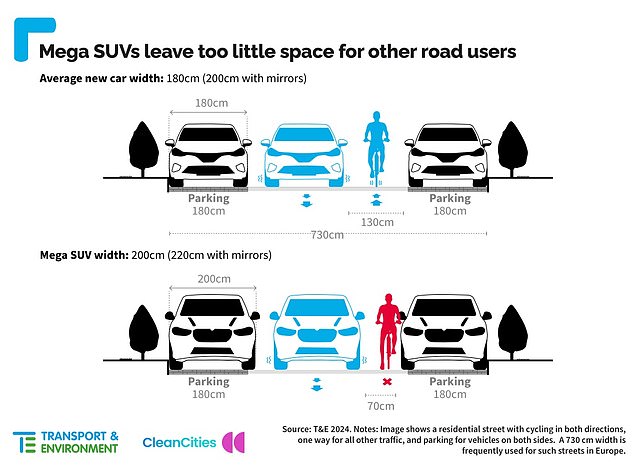
Transport & Environment says that the wider cars leave less room for other road users
The research shows that the average width of new cars increased to 180.3 cm in the first half of 2023, compared to 177.8 cm in 2018.
Historical data from the International Council on Clean Transportation (ICCT) shows that this trend of new cars increasing in width by 1cm every two years has continued over the two decades to 2020.
The report points out that certain cars have grown significantly: the new generation Land Rover Defender is 20cm wider than the old 4×4 and BMW’s X5 has grown 6cm in six years.
In 2023, Volvo as a brand – which abandons conventional cars in favor of SUVs – became 4.1 cm wider in one year.
A survey of several European markets shows that only Germany currently has more new cars for sale than Britain.
This is mainly a result of the growing demand for SUVs in recent years.
Exclusive new car market analysis by This is Money showed how much SUV sales have accelerated over the past decade versus other types of passenger cars.
Official registration data shows that in 2013, two in five (39.5 percent) of all new passenger cars on the road were superminis and city cars.
Although they are still the most purchased new cars today, they only accounted for one in three (30.4 percent) registrations in 2023 – and it is the SUV that is eroding their market dominance.
Ten years ago, dual-purpose SUVs represented just 11 percent of the market.
But huge demand in recent years has seen SUVs overtake family cars to become the country’s second most popular car type, accounting for 28.6 percent of all registrations.
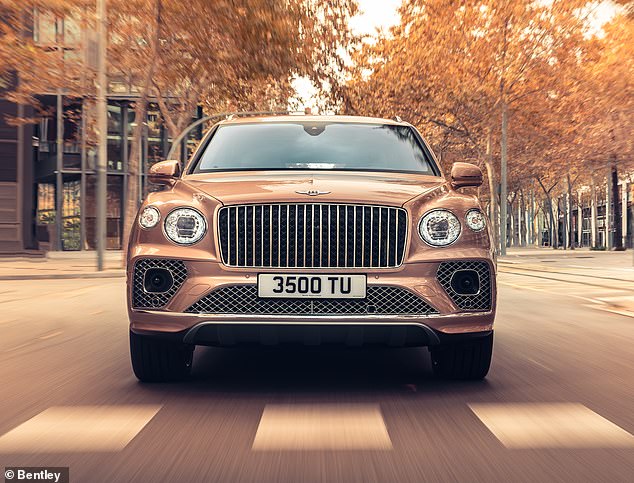
Transport & Environment has blamed luxury SUVs for the bloat of new cars sold in Britain. Pictured: Bentley’s Bentayga SUV
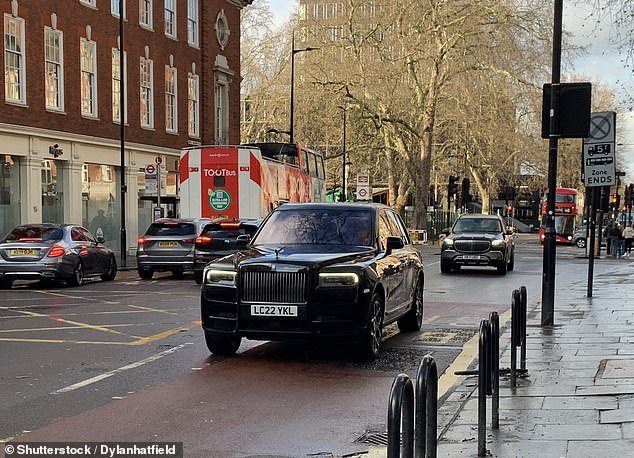
Rolls-Royce’s £300,000 Cullinan is one of the widest cars currently sold in Britain, measuring 2.16 meters in circumference. It means that this luxury SUV cannot be legally parked in most city on-street parking lots
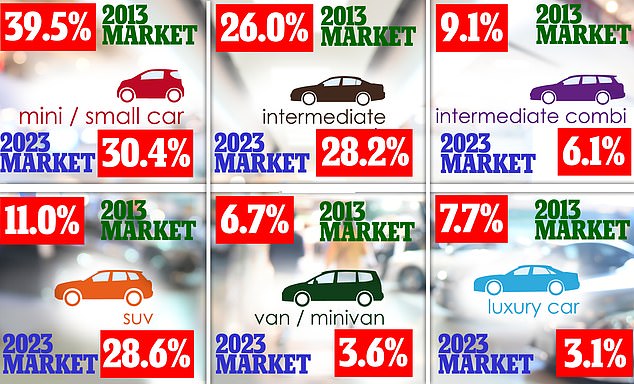
In 2013, SUVs represented just over one in ten (11%) of all new cars. Fast forward ten years and they now account for almost three in ten (28.6%). In terms of passenger car type, only city cars/superminis are sold in larger numbers
T&E says that while new cars are sold in Britain subject to the same maximum width of 255 cm as buses and trucks. A review of these rules must be carried out before Britain’s streets become overrun with excessive vehicles.
It says more than half of new cars sold in 2023 were already too wide for the minimum on-street parking space of 180cm in major British cities.
This makes legal parking of large and luxury SUVs impossible – and can lead to fines if the vehicle is outside the designated white lines.
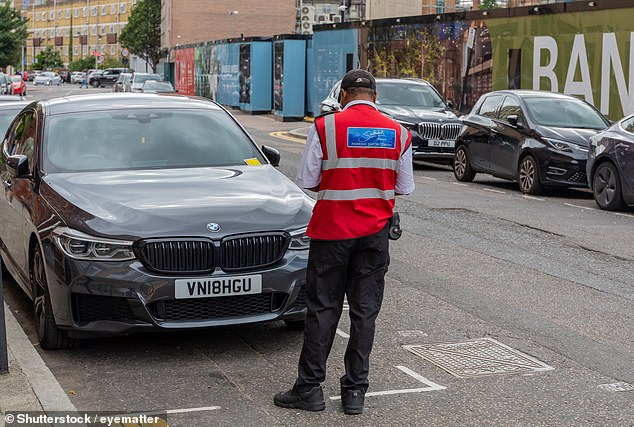
Failure to park within the white lines of a conventional on-street parking space in a city (such as this one in London) can result in a fine for motorists
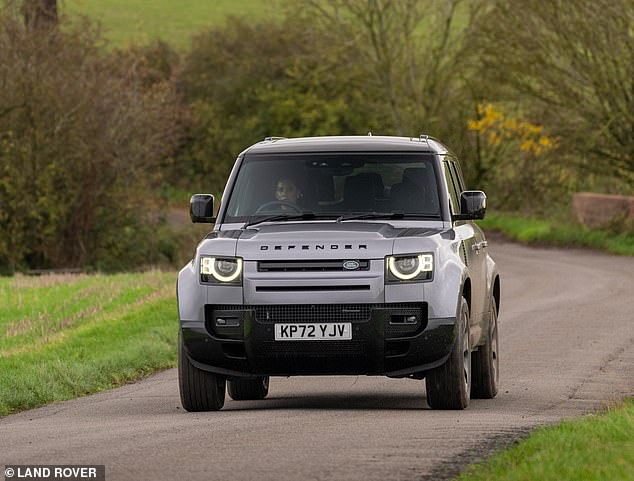
T&E says the latest Land Rover Defender is about 8 inches wider than the previous generation off-roader. This becomes a major problem for narrow city streets and single-lane rural roads
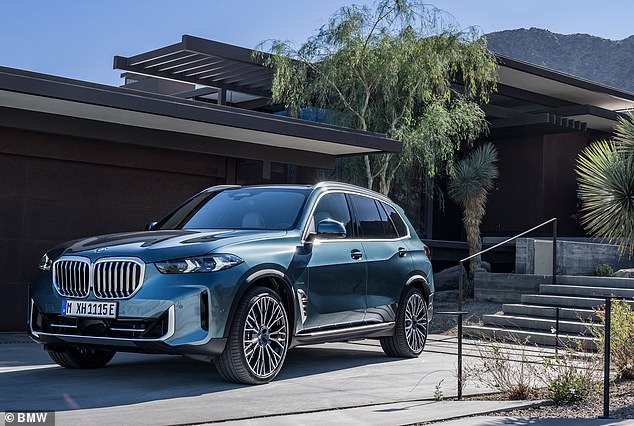
According to the research, the BMW X5 on sale today is about 6 cm wider than the one in showrooms six years ago
The widest SUV currently sold in Britain – albeit in very limited numbers – is the Hummer EV.
London-based luxury car dealer Clive Sutton imports the electric beast for British customers, although at 230cm wide it is half a meter too thick to fit in an on-street parking space in cities like London.
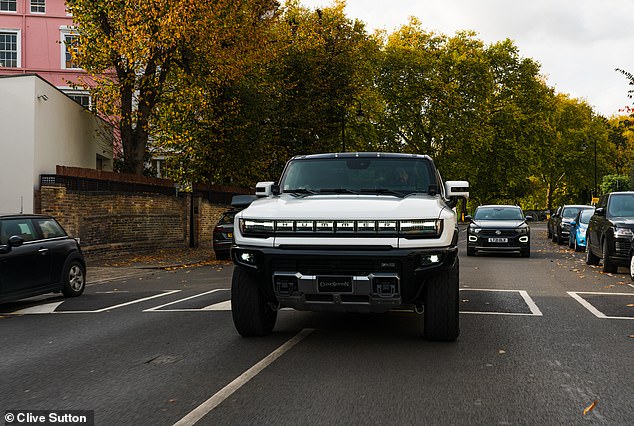
This colossal Hummer EV is 2.3 meters wide. It dwarfs the conventional cars sold in Britain and looks huge on the busy streets of London (pictured)
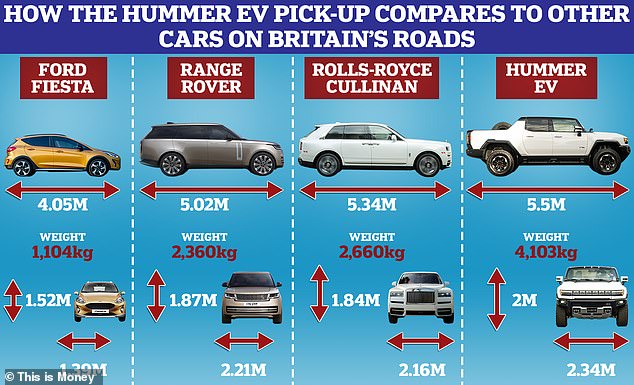
How does the Hummer EV compare to other cars on UK roads? It will eclipse and Range Rover and even a Rolls-Royce Cullinan, both extremely large SUVs
And T&E believes these hulking Chelsea tractors will ‘put even more pressure on the roads through competing applications’.
The report states: ‘The trend towards wider vehicles is reducing the available road space for other vehicles and cyclists, while parked cars are increasingly encroaching on footpaths.
‘The wider designs have also made it possible to further increase the height of vehicles, despite accident data showing that a 10cm increase in the height of vehicle fronts carries a 30 per cent higher risk of fatalities in collisions with pedestrians and cyclists.’
The think tank says UK legislation around vehicle width is still inherited from the EU and could be independently reviewed after Brexit.
It says a mandatory width limit for cars should be introduced from 2030 – which should also be law for EU markets – to prevent passenger cars taking up more street space.
Richard Hebditch, managing director of T&E UK, said: ‘The trend for cars to become wider has been going on for decades and will continue until Britain imposes stricter limits.
‘We currently allow new cars to be as wide as trucks. This has meant that our roads are now home to large SUVs and American-style pick-ups parking on our sidewalks, endangering pedestrians and cyclists and making everyone else on our roads less safe.”
Sarah McMonagle, director of external affairs at Cycling UK, said that people who drive the widest vehicles are the ones who “have the most are likely to pass people who cycle closer than those who cycle narrower’.
She says this is especially the case on narrow rural roads or residential streets with lots of parking, where people on bikes are often ‘bullied off the road to make way’.
McMonagle added: ‘We need government action to stop car manufacturers fueling our addiction to ever heavier cars.
‘Bigger cars are not better, they are less durable, make our roads more dangerous and take up more space, increasing traffic jams.’
Some links in this article may be affiliate links. If you click on it, we may earn a small commission. That helps us fund This Is Money and keep it free to use. We do not write articles to promote products. We do not allow a commercial relationship to compromise our editorial independence.
